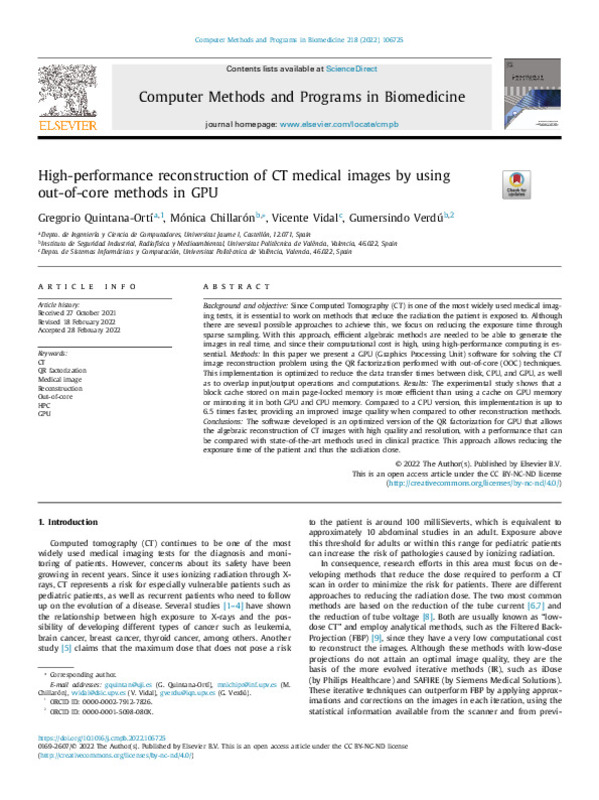Quintana-Ortí, G.; Chillarón-Pérez, M.; Vidal-Gimeno, V.; Verdú Martín, GJ. (2022). High-performance reconstruction of CT medical images by using out-of-core methods in GPU. Computer Methods and Programs in Biomedicine. 218:1-11. https://doi.org/10.1016/j.cmpb.2022.106725
Por favor, use este identificador para citar o enlazar este ítem: http://hdl.handle.net/10251/194678
|
Título:
|
High-performance reconstruction of CT medical images by using out-of-core methods in GPU
|
|
Autor:
|
Quintana-Ortí, Gregorio

 CHILLARÓN-PÉREZ, MÓNICA
CHILLARÓN-PÉREZ, MÓNICA

 Vidal-Gimeno, Vicente-Emilio
Vidal-Gimeno, Vicente-Emilio

 Verdú Martín, Gumersindo Jesús
Verdú Martín, Gumersindo Jesús
|
|
Entidad UPV:
|
Universitat Politècnica de València. Escuela Técnica Superior de Ingenieros Industriales - Escola Tècnica Superior d'Enginyers Industrials
Universitat Politècnica de València. Departamento de Sistemas Informáticos y Computación - Departament de Sistemes Informàtics i Computació
Universitat Politècnica de València. Escola Tècnica Superior d'Enginyeria Informàtica
|
|
Fecha difusión:
|
|
|
Resumen:
|
[EN] Background and objective: Since Computed Tomography (CT) is one of the most widely used medical imaging tests, it is essential to work on methods that reduce the radiation the patient is exposed to. Although there are ...[+]
[EN] Background and objective: Since Computed Tomography (CT) is one of the most widely used medical imaging tests, it is essential to work on methods that reduce the radiation the patient is exposed to. Although there are several possible approaches to achieve this, we focus on reducing the exposure time through sparse sampling. With this approach, efficient algebraic methods are needed to be able to generate the images in real time, and since their computational cost is high, using high-performance computing is essential. Methods: In this paper we present a GPU (Graphics Processing Unit) software for solving the CT image reconstruction problem using the QR factorization performed with out-of-core (OOC) techniques. This implementation is optimized to reduce the data transfer times between disk, CPU, and GPU, as well as to overlap input/output operations and computations. Results: The experimental study shows that a block cache stored on main page-locked memory is more efficient than using a cache on GPU memory or mirroring it in both GPU and CPU memory. Compared to a CPU version, this implementation is up to 6.5 times faster, providing an improved image quality when compared to other reconstruction methods. Conclusions: The software developed is an optimized version of the QR factorization for GPU that allows the algebraic reconstruction of CT images with high quality and resolution, with a performance that can be compared with state-of-the-art methods used in clinical practice. This approach allows reducing the exposure time of the patient and thus the radiation dose.
[-]
|
|
Palabras clave:
|
CT
,
QR factorization
,
Medical image
,
Reconstruction
,
Out-of-core
,
HPC
,
GPU
|
|
Derechos de uso:
|
Reconocimiento - No comercial - Sin obra derivada (by-nc-nd)
|
|
Fuente:
|
Computer Methods and Programs in Biomedicine. (issn:
0169-2607
)
|
|
DOI:
|
10.1016/j.cmpb.2022.106725
|
|
Editorial:
|
Elsevier
|
|
Versión del editor:
|
https://doi.org/10.1016/j.cmpb.2022.106725
|
|
Código del Proyecto:
|
info:eu-repo/grantAgreement/AEI/Plan Estatal de Investigación Científica y Técnica y de Innovación 2017-2020/RTI2018-098156-B-C54/ES/TECNICAS PARA LA ACELERACION Y MEJORA DE APLICACIONES MULTIMEDIA Y HPC/
info:eu-repo/grantAgreement/GENERALITAT VALENCIANA//PROMETEO%2F2018%2F035//BIOINGENIERIA DE LAS RADIACIONES IONIZANTES. BIORA/
info:eu-repo/grantAgreement/GVA//ACIF%2F2017%2F075//AYUDA PREDOCTORAL CONSELLERIA-CHILLARON PEREZ/
|
|
Agradecimientos:
|
This research has been supported by the "Universitat Politecnica de Valencia", "Generalitat Valenciana" under PROMETEO/2018/035 and ACIF/2017/075, co-financed by FEDER and FSE funds, and the "Spanish Ministry of Science, ...[+]
This research has been supported by the "Universitat Politecnica de Valencia", "Generalitat Valenciana" under PROMETEO/2018/035 and ACIF/2017/075, co-financed by FEDER and FSE funds, and the "Spanish Ministry of Science, Innovation and Universities" under Grant RTI2018-098156-B-C54 co-financed by FEDER funds. The authors would also like to thank Francisco D. Igual (Universidad Complutense de Madrid) for granting access to the volta1 server.
[-]
|
|
Tipo:
|
Artículo
|









